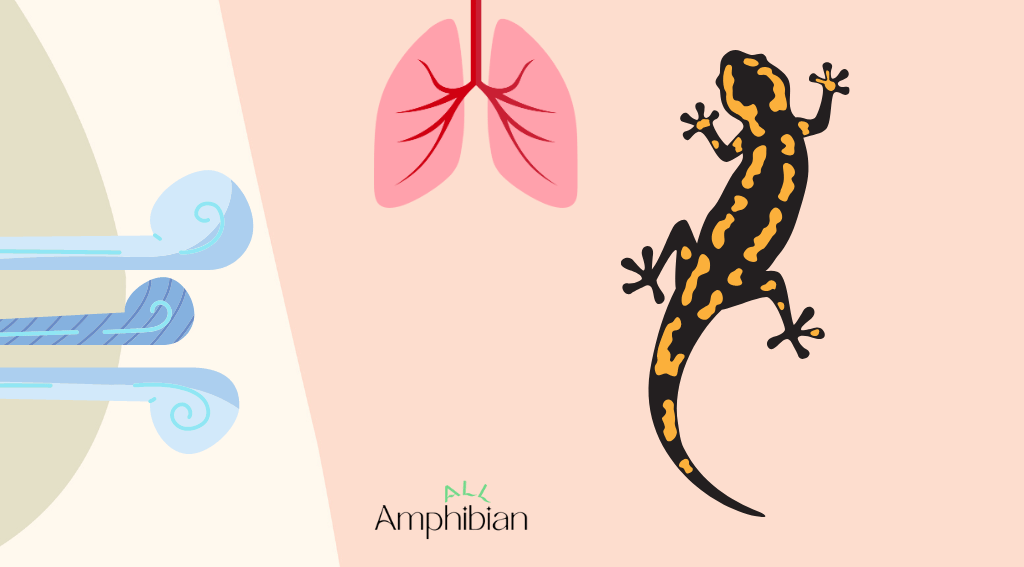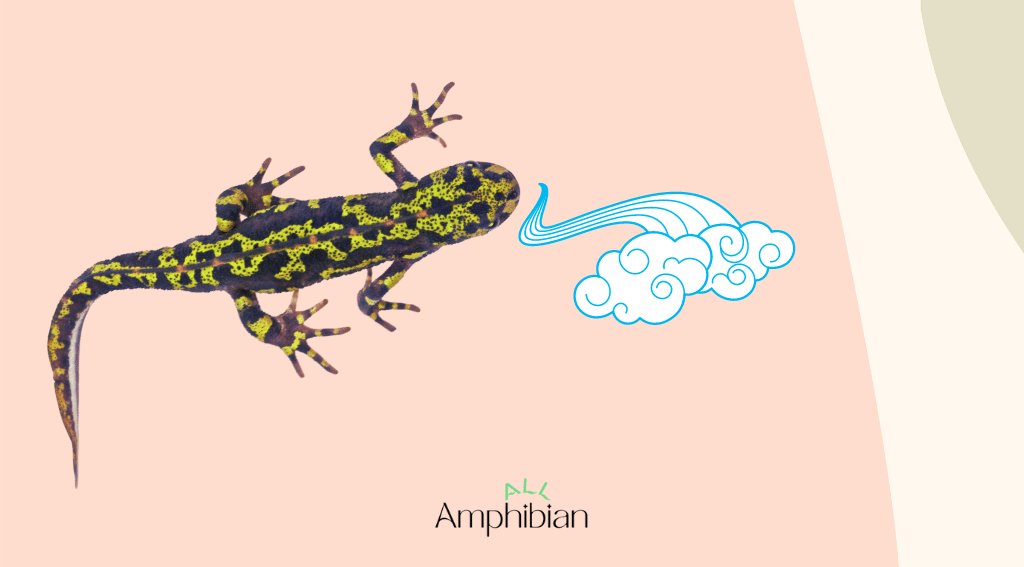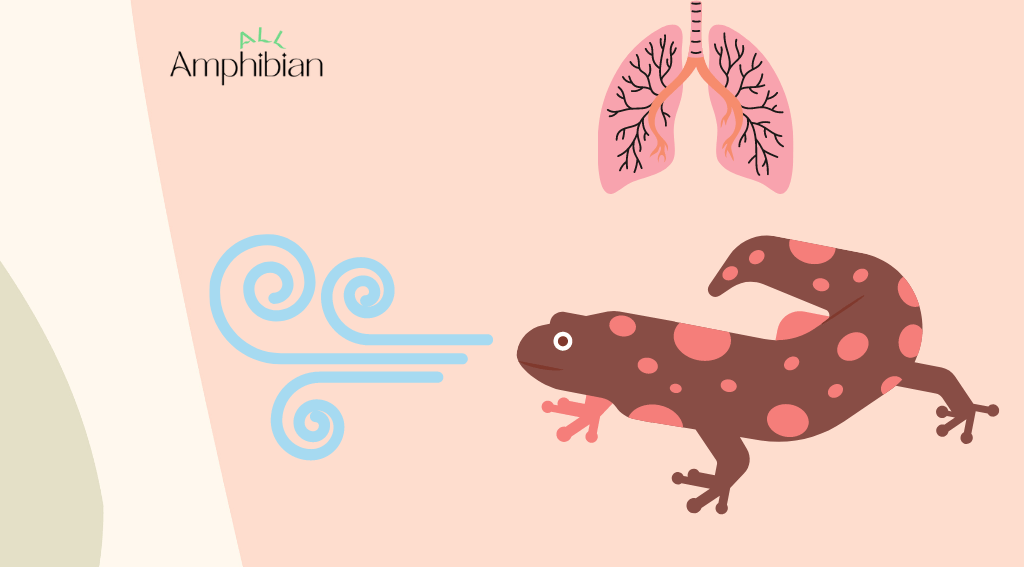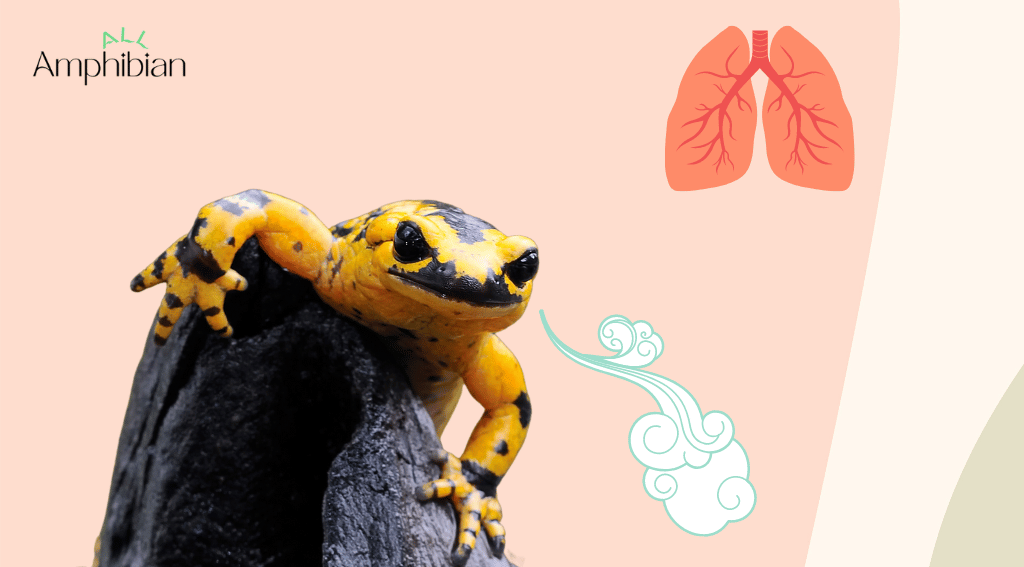Salamanders are divided into two terrestrial and aquatic groups. Each of them has a different respiratory system. All salamanders can breathe through their skin, but they also breathe in other ways. In this article, we want to examine the respiratory system of salamanders from the Amphibian family.
How salamanders breathe and their respiratory systems

Salamanders are amphibians. They have a two-stage life. Salamanders have a different respiratory systems in each stage of their life. Most salamanders lay their eggs in water. When they hatch and begin their larval life, they are completely aquatic and have gills like fish, but after some time they undergo changes that are called metamorphosis. Terrestrial salamanders lose their gills when they reach maturity, and their lungs are complete.
Then they enter the land and breathe through their lungs. Salamanders can also breathe through their skin. Some terrestrial salamanders, such as the tiger salamander, do not have lungs. They breathe through the skin and the thin membrane of the throat and mouth. Aquatic salamanders also keep their gills and breathe through their gills and skin. Some aquatic salamanders also lose their gills but do not leave the water. They absorb oxygen dissolved in water through their skin. Almost all salamanders can breathe through the skin and thin membrane inside their mouth and throat.
How do salamander larval Breathe?
Salamanders begin their life as salamander larvae. At this time, they are completely aquatic and breathe with their gills. Their feather-like lungs protrude from both sides of their heads and are visible. They breathe through these gills throughout their larval life.
Then when they reach maturity, terrestrial salamanders lose these gills. Some species of salamander, like the fire salamander, do not have an underwater larval stage. They lay their eggs outside the water in wet places and the baby salamanders look just like their parents when they hatch.
Salamander larvae take from 3 weeks to 3 months to reach full maturity. After a little growth, they start to complete their lungs. In the middle of the larval period, some salamanders can breathe through their lungs. Especially in waters with low oxygen levels, salamander larvae sometimes come to the water surface and swallow a sip of air from the bubbles on the water surface and go down. At the end of their larval stage, salamander larvae acquire the ability to breathe through the skin. When salamander larvae reach maturity, they can breathe completely through their skin.
How do aquatic salamanders breathe

Salamanders undergo metamorphosis when they reach maturity. They lose their gills and their lungs emerge. Their hands and feet grow and they can enter land. But some salamanders, such as axolotls, do not pass the larval stage completely. They do not lose their gills and live in water for the rest of their lives.
They have feather-like gills that consist of an extensive network of blood vessels that are very close to the surface of the skin. Oxygen in the water is absorbed into the blood in contact with their gills, and at the same time, carbon dioxide also passes through the skin and enters the water.
Apart from gills, aquatic salamanders can also breathe through their skin. Their skin, like their gills, has high absorption properties. Their blood vessels are very close to the surface of the skin and can absorb oxygen from the water. Some aquatic salamanders have lungs. They come to the surface of the water when the oxygen in the water is low and breathe air. They also use their lungs to stay submerged in water. The oxygen in the lungs keeps them submerged in water.
Aquatic salamanders can also absorb air oxygen through their skin. They can breathe outside the water. But they cannot get all the oxygen they need through their skin. For this reason, they cannot survive outside the water for a long time and must return to the water. The gills of aquatic salamanders are different from those of other aquatic creatures. Aquatic organisms such as fish must move in water to breathe. But aquatic salamanders can remain motionless in the water and breathe. By shaking their lungs in the water, they make more water come into contact with their lungs and absorb more oxygen.
How do terrestrial salamanders breathe?

Most salamanders reach adulthood after passing through the larval stage. They lose their gills and their lungs emerge. Their hands and feet grow and they enter the land. At this time, they can breathe air through their lungs. Only a few terrestrial salamanders have developed lungs and most of them have primitive lungs.
Their lungs do not provide all the oxygen they need. For this reason, they absorb the rest of the oxygen they need through their skin. Their skin has glands that keep their skin moist with their secretions. This moisture helps them to breathe. That’s why salamanders always live in wet areas. Salamanders also have thin skin inside their mouths and throats.
They can also breathe through the thin membrane inside their mouth and throat. Some terrestrial salamanders are lungless. They lose their gills at puberty, but their lungs do not grow. Lungless salamanders absorb the oxygen they need through their skin and the thin membrane inside their mouths and throats. Their skin can absorb more oxygen. Terrestrial salamanders can also breathe in water. Their skin absorbs oxygen in the water, but this oxygen is not enough for salamanders to survive; that’s why they can’t stay in the water for a long time and have to come out of the water to breathe.
What factors affect salamander’s breathing?
Salamanders have an amazing respiratory system. Even some terrestrial salamanders have gills. They do not leave the water when they mature and do not lose their gills if there is food in the aquatic environment and they have suitable conditions for living in the water. Also, when the living conditions on land are very difficult, they stay in the water and keep their gills. In general, the following factors affect the breathing of salamanders.
- Ambient temperature
One of the important factors in the breathing of salamanders is the ambient temperature. If the air temperature is high, salamanders’ skin becomes dry and their breathing becomes difficult. Also, they cannot breathe well in warm water because there is less oxygen in warm water than in cold water. Also, salamanders cannot control their body temperature and their body temperature goes up or down with the ambient temperature. Because of this, in warmer environments, their body’s metabolism increases, and they need more oxygen.
- Oxygen level
Another factor that affects the breathing of salamanders is the amount of oxygen in the water. Salamanders and salamander larvae breathe better in waters that have more movement. The movement of water causes more oxygen from the atmosphere to dissolve in the water, and its oxygen level is higher than stagnant water. For this reason, salamanders breathe better in running water.
- Skin Surface
The skin surface of salamanders has a great effect on their breathing. All salamanders breathe through their skin. The wider the surface of salamanders’ skin, the more water or air it comes in contact with and the more oxygen it can absorb. Some salamanders have wrinkled skin for better breathing. These wrinkles increase the contact surface of the skin with water or air and as a result, absorb more oxygen. This is the reason why the gills of salamanders are feather-like
- Salamander’s activity
amount of activity also has a great effect on the breathing of salamanders. Like humans, salamanders need more oxygen when they are more active. For this reason, salamanders usually hide under leaves and between stones and rest. By reducing their metabolism, they use less oxygen.
- Humidity
Humidity is another important factor that affects the breathing of salamanders. Salamanders always live in humid places and their skin is always slimy and moist. This moisture is created by their skin glands because it allows their skin to absorb oxygen. If their skin becomes dry, they will have problems for breathing. This is the reason why land salamanders will have breathing problems if they are placed in dry places or if water salamanders stay out of the water for a long time.
Conclusion about how salamanders breathe

Salamanders are amphibians. They have a two-stage life and have a different respiratory system in each stage of their life. Most salamanders lay their eggs in water. Salamander larvae are aquatic when they hatch. Like fish, they have gills. But their gills are different from other aquatic animals.
Salamander larvae have feather-like gills that can be moved to breathe without moving in the water. Their gills have extensive blood vessels that are very close to the surface of their skin. Oxygen dissolved in water is absorbed into the blood in contact with their gills, and at the same time, carbon dioxide enters the water from their blood.
When salamander larvae reach maturity, they lose their gills and their lungs appear. Terrestrial salamanders leave the water when they mature and can breathe air through their lungs. Aquatic salamanders retain their gills when they mature and stay in the water for the rest of their lives.
Their gills do not provide all the oxygen they need; that’s why they can breathe through the skin and the thin membrane inside their mouth and throat. Terrestrial salamanders do not have developed lungs. For this reason, apart from their lungs, they can also breathe through the skin and the thin membrane inside their mouths and throats. Some terrestrial salamanders are lungless. Also, some aquatic salamanders are without gills. They breathe through their skin.
Factors such as the temperature of the environment, the amount of oxygen in the water, the extent of the skin surface, the level of skin moisture, and the activity level of salamanders affect salamanders’ breathing. Some terrestrial salamanders do not leave the water if the living conditions in the water are favorable or the living conditions on land are unfavorable. They keep their gills and live the rest of their lives in water.
FAQ
- How do salamanders breathe?
In general, salamanders can breathe in three ways. They can breathe through their lungs, gills, and skin and thin membrane inside their mouth and throat.
- How do salamander larvae breathe? Salamanders lay their eggs in water. Salamander larvae are completely aquatic when they hatch. They have feather-like gills on either side of their heads that have many blood vessels that are very close to the surface of the skin. The oxygen in the water is absorbed into the blood in contact with their gills.
- How do aquatic salamanders breathe?
Aquatic salamanders do not lose their gills when they reach maturity. They do not leave the water and breathe through their gills. In addition to gills, aquatic salamanders can breathe through their skin and the thin membrane inside their mouth and throat.
- How do terrestrial salamanders breathe?
Land salamanders lose their gills when they mature and their lungs appear. They leave the water and can breathe air through their lungs. They have primitive lungs and do not provide all the oxygen they need. For this reason, they can breathe through the skin and thin membrane inside the mouth and throat.
- What factors affect salamander’s breathing?
The ambient temperature, the amount of oxygen in the water, the extent of the skin surface, the activity level of salamanders, and the moisture level of their skin are factors that have a great impact on the breathing of salamanders.

